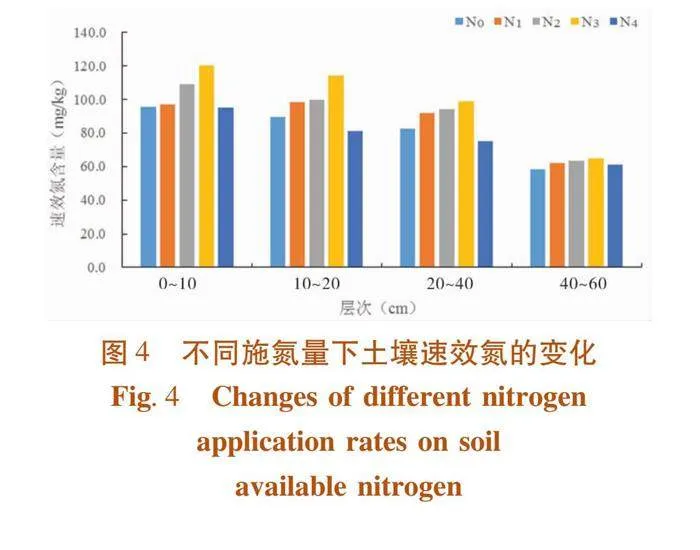
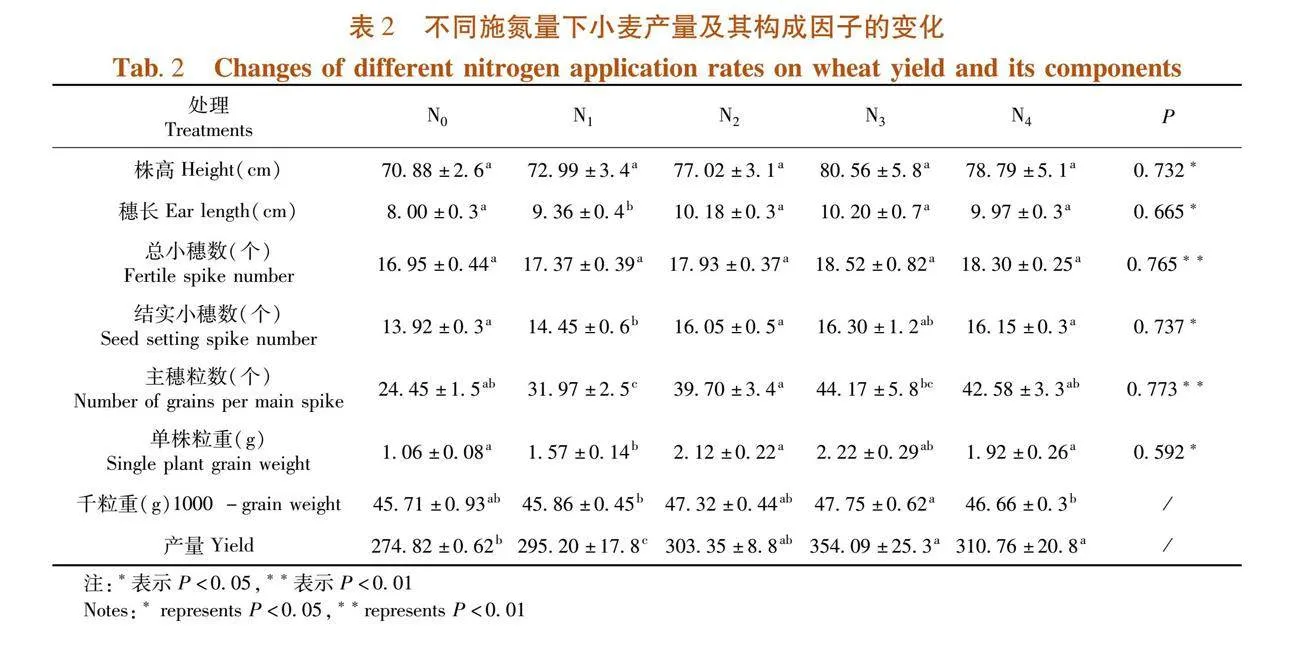
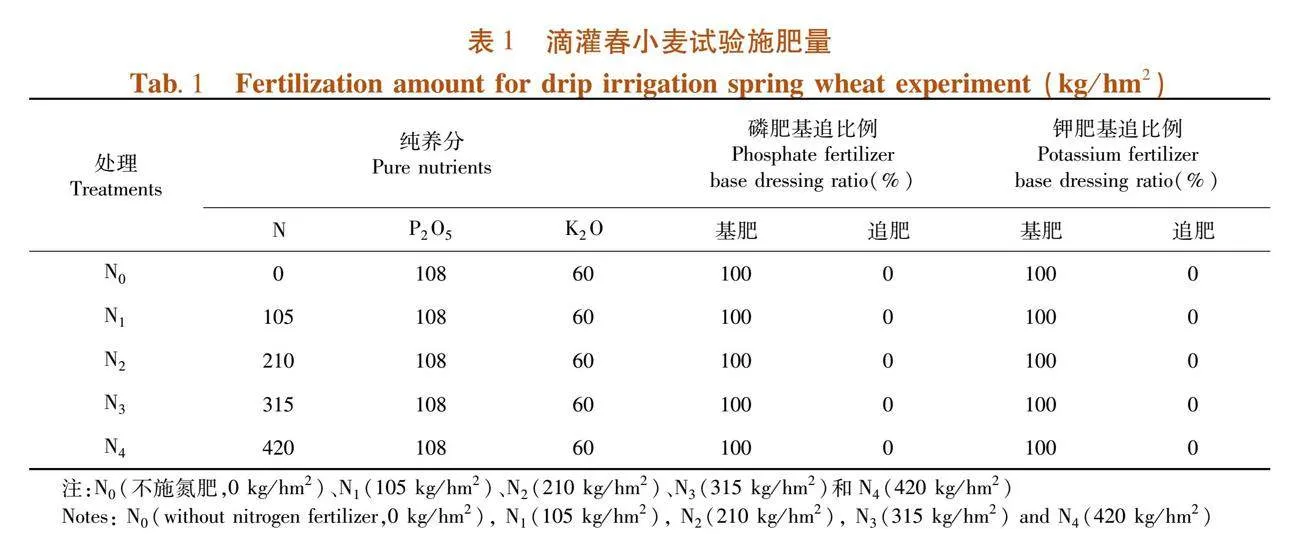
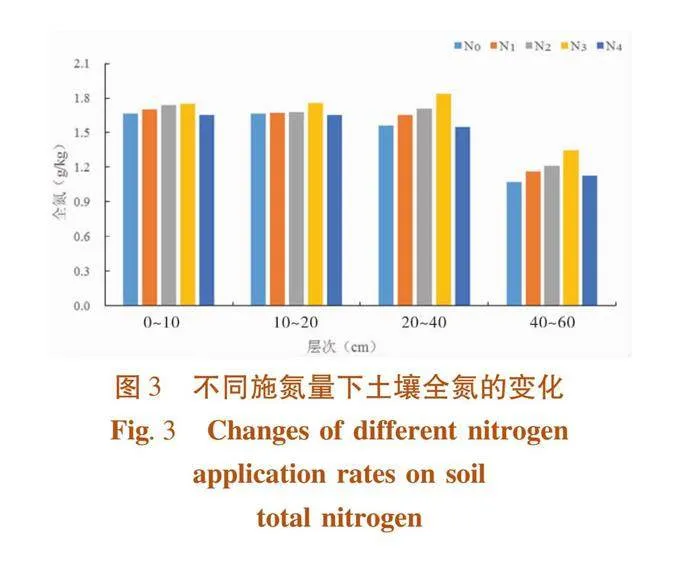
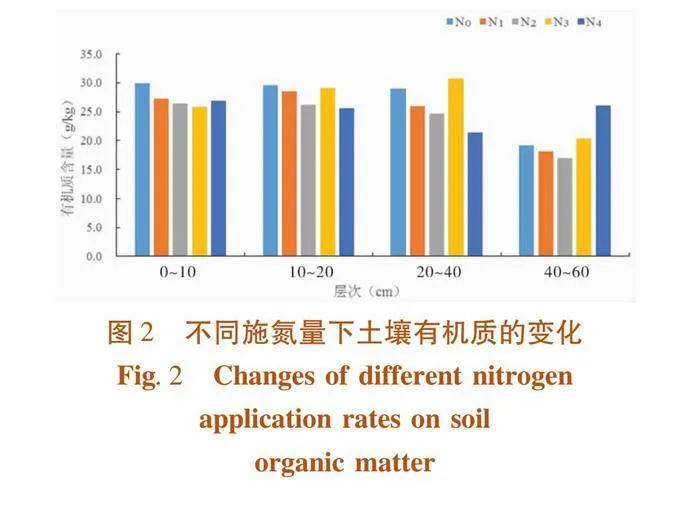
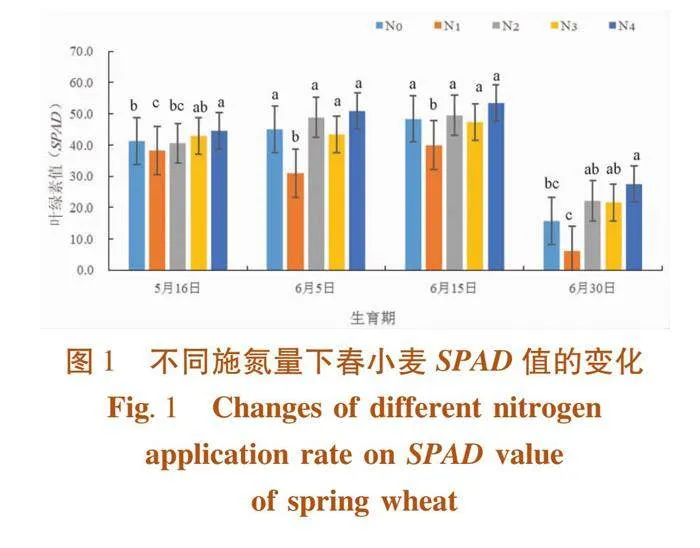
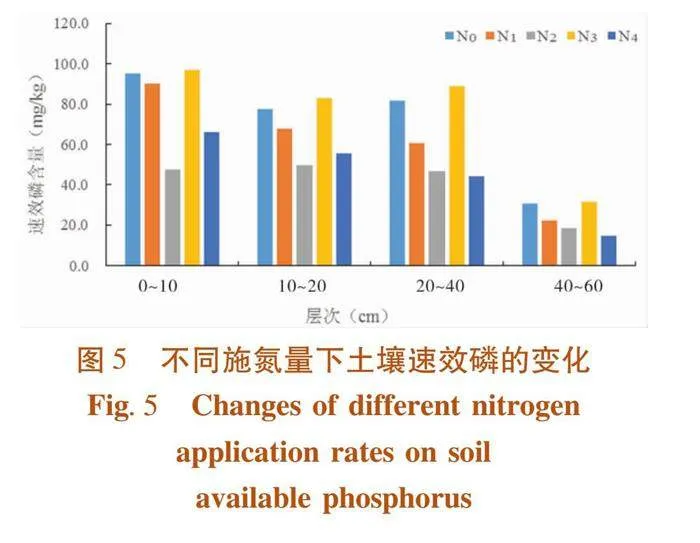
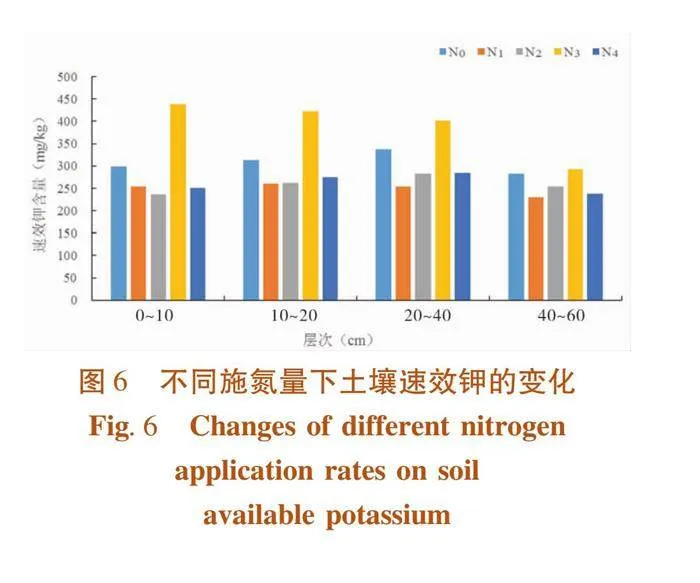
摘 要:【目的】研究不同施氮量对滴灌小麦生长特性及土壤养分含量的影响,探索适宜小麦养分积累、生长发育的施氮量,为科学合理施用化肥提供数据支撑。
【方法】以滴灌春小麦为研究对象,通过田间小区试验,设置对照0 kg/hm2(N0)、105 kg /hm2(N1)、210 kg/hm2、(N2)、315 kg/hm2(N3)和420 kg /hm2(N4) 5个施氮量水平,分析各处理对春小麦生长性状(SPAD值、产量及产量构成因子)和不同层次土壤养分(有机质、全氮、速效氮、速效磷和速效钾)积累的影响差异。
【结果】春小麦在拔节期、孕穗期、扬花期和灌浆期的 SPAD值随施氮量的上升而上升,施氮量为315 kg /hm2较利于 SPDA 值的积累。0~10 cm土壤有机质含量随施氮量的增加呈先减后增的趋势;10~40 cm土壤有机质含量随施氮量的增加呈先减后增再减的趋势;40~60 cm土壤有机质含量随施氮量的增加呈先减少后增加的趋势;0~60 cm土壤全氮、速效氮含量每层均随施氮量的增加均呈先增加后减少的趋势;0~60 cm土壤速效磷、速效钾含量每层均随施氮量的增加呈先减少后增加再减少的趋势。产量与株高、穗长、总小穗数、结实小穗数、主穗粒数和单株粒重均显著相关(P<0.05,相关系数分别为0.732*、0.665*、0.765**、0.737*、0.773**和0.592*)。不同处理的产量排序为N3>N4>N2>N1>N0,施氮量为315 kg/hm2时最有利于提高春小麦产量。
【结论】施氮量为315 kg /hm2 时,更适宜新疆南疆春小麦的生长。
关键词:施氮量;土壤养分;春小麦;产量
中图分类号:S512 ""文献标志码:A
文章编号:1001-4330(2025)01-0087-08
收稿日期(Received):
2024-07-11
基金项目:
新疆小麦产业技术体系(XJARS-01-21);不同土地利用方式对土壤有机碳组分及土壤微生物量碳氮的影响(nkyzzkj-013);中央引导地方科技发展专项资金“新疆遥感与农业大数据应用服务平台”
作者简介:
李娜(1992-),女,新疆乌鲁木齐人,助理研究员,硕士,研究方向为农业大数据与农业遥感,(E-mail)1162326631@qq.com
通信作者:
陈署晃(1973-),女,湖南人,研究员,硕士,研究方向为土壤肥料与农业信息技术,(E-mail)chensh66@163.com
0 引 言
【研究意义】新疆小麦种植面积约80×104 hm2,其中春小麦约24×104 hm2[1]。氮素是植物生长发育所必需的营养元素之一,合理施用氮肥是提高作物产量的必要措施[2]。施氮水平对小麦产量有显著影响[3],合理施用氮肥能更好的促进小麦的生长发育,在一定程度上提高了小麦产量及品质。而氮肥施用过量不仅达不到高产的效果,也会降低小麦的产量,甚至还会破坏土壤质量。【前人研究进展】有关施氮量对小麦氮素、磷素、钾素的积累[4]、SPAD值氮营养的管理[5]和产量[6-8]的影响有很多相关研究。合理施用氮肥能够提高小麦的产量,找到适宜小麦的施氮量是近来研究的热点,不同地区的最适施氮量水平也有所差异。合理施用氮肥可显著提升小麦的产量,对小麦产量的贡献率可达到20.96%以上[6]。张磊等[9]研究结果表明,水肥一体施肥量比常规施肥量高3.0%左右时,既能提高肥料的利用效率,也能提升小麦的产量。【本研究切入点】目前新疆南疆极端干旱区对滴灌春小麦施肥的研究相对较少。因此,需探索不同施氮水平对小麦产量及其理化性质的影响,找到适合该区域的施氮水平。【拟解决的关键问题】研究滴灌春小麦不同施氮量的理化性质及对产量和产量构成因素的效应,为科学合理的施用氮肥提供数据支撑。
1 材料与方法
1.1 材 料
研究区位于新疆拜城县农业试验站试验地(81°54′E,41°47′N,海拔1 231 m)属中温带大陆性干旱气候,年均气温为7.6℃,年均降水量为171.13 mm。土壤质地为壤土、土层厚度在60 cm左右。试验地前茬作物为春小麦,地块平坦、整齐、肥力均匀,整好地块后,将每个处理单独布设灌水施肥装置,单独安装球阀,总进水管安装水表读数。
1.2 方 法
1.2.1 试验设计
田间小区试验设置对照0 kg/hm2(N0)、105 kg /hm2(N1)、210 kg/hm2、(N2)、315 kg/hm2(N3)和420 kg /hm2(N4) 5个施氮量水平。表1
1.2.2 土壤样品采集与测定
基础土样:播种前采集土层0~60 cm(0~10 cm、10~20 cm、20~40 cm、40~60 cm)的土样,带回实验室测定有机质(重铬酸钾外加热氧化法测定)、全氮(浓H2SO4、K2SO4-CuSO4混合催化剂消解法)、速效氮(硝态氮、铵态氮)、有效磷(Olsen-P)、速效钾(醋酸铵提取)。
土壤养分:在小麦拔节期、孕穗期、扬花灌浆期、成熟期采取各处理的0~60 cm土层,测定土壤全氮、有机质、速效氮、有效磷、速效钾。每次施肥灌水后第5 d按上述方法取样。
1.2.3 生长特性参数及产量
叶绿素:5月16日、6月5日、6月15日及6月30日,利用叶绿素仪测定不同处理春小麦叶片的叶绿素值,在不同施氮水平下确定测量区域,在每个小区选取10株小麦苗,求取10株的平均值。
产量及其构成因子:在每个处理随机选取10株小麦,测定其株高、穗长、总小穗数、结实小穗数、主穗粒数、单株粒重和千粒重等。
1.3 数据处理
试验数据处理采用Excel 2010、ArcGIS、Origin 2020、Statistics SPSS 22.0软件。
2 "结果与分析
2.1 不同施氮量水平对春小麦SPAD值的响应
研究表明,不同施氮量对春小麦各个生育期的SPAD值均有影响。各个生育期春小麦SPAD值均随着施氮量的增加呈一致增加的趋势(N3>N2>N1>N0)。4个时期,春小麦SPAD值平均值差异均为极显著(P<0.05),施氮量对春小麦的SPAD值产生影响。拔节期时,N1、N2处理均对春小麦SPAD值的影响不显著,N3处理对春小麦SPAD值有显著影响,施氮量在315 kg/hm2时对春小麦SPAD值的积累最有利;孕穗期时,与N0处理相比,N2和N3处理均对春小麦SPAD值的积累有显著影响,因此,施氮量为315 kg/hm2时最适宜春小麦生长;扬花期和灌浆期,N1处理对春小麦SPAD值影响不显著,与N0和N1处理相比,N2和N3处理显著影响春小麦的SPAD值,施氮量在210和315 kg/hm2时最有利于春小麦SPAD值的积累。春小麦在拔节期、孕穗期、扬花期和灌浆期,最适宜的施氮量分别为315、315、210和315 kg/hm2。图1
2.2 不同施氮量处理对土壤养分的影响
2.2.1 不同施氮量对土壤有机质的影响
研究表明,不同施氮量下的有机质含量变化趋势均不同,0~10 cm土壤有机质含量随施氮量的增加呈先减少后增加的趋势,有机质在N0处理含量最高,为29.96 g/kg;在N3处理有机质含量最低,为25.87 g/kg;10~20 cm 土壤有机质含量随施氮量的增加呈先降后升再降的趋势;有机质在N0处理含量最高,为29.59 g/kg;在N4处理有机质含量最低,为25.61 g/kg;20~40 cm 土壤有机质含量随施氮量的增加呈先降后增、再降的趋势;有机质在N3处理含量最高,为30.77 g/kg;在N4处理有机质含量最低,为21.37 g/kg;40~60 cm 土壤有机质含量随施氮量的增加呈先减少后增加的趋势;有机质在N4处理含量最高,为26.04 g/kg;在N2处理有机质含量最低,为16.98 g/kg。图2
2.2.2 不同施氮量对土壤全氮的影响
研究表明,不同施氮量下的0~60 cm全氮含量变化趋势一致,0~10 cm 土壤全氮含量随施氮量的增加呈先增加后减少的趋势,全氮在N3处理含量最高,为1.75 g/kg;在N4处理全氮含量最低,为1.65 g/kg;10~20 cm 土壤全氮含量随施氮量的增加呈先增加后减少的趋势,全氮在N3处理含量最高,为1.76 g/kg;在N4处理全氮含量最低,为1.65 g/kg;20~40 cm 土壤全氮含量随施氮量的增加呈先增加后减少的趋势,全氮在N3处理含量最高,为1.84 g/kg;在N4处理全氮含量最低,为1.55 g/kg;40~60 cm 土壤全氮含量随施氮量的增加呈先增加后减少的趋势,全氮在N3处理含量最高,为1.35 g/kg;在N0处理全氮含量最低,为1.07 g/kg。0~40 cm 的土壤全氮含量均在N3处理最高,N4处理最低,但在40~60 cm全氮在N3处含量最高,N0处理含量最低,施氮量对0~40 cm 土壤全氮影响较大,对40~60 cm 影响较小。土壤全氮含量随着施氮量的增加呈上升趋势,20~40 cm趋势更为明显。图3
2.2.3 不同施氮量对土壤速效氮的影响
研究表明,不同施氮量下的速效氮含量变化趋势大致相同,0~10 cm土壤速效氮含量随施氮量的增加呈先增加后减少的趋势,速效氮在N3处理含量最高,为120.30 mg/kg;在N4处理速效氮含量最低,为95.21 mg/kg;10~20 cm土壤速效氮含量随施氮量的增加呈先增加后减少的趋势,速效氮在N3处理含量最高,为114.01 mg/kg;在N4处理速效氮含量最低,为81.22 mg/kg;20~40 cm土壤速效氮含量随施氮量的增加呈先增加后减少的趋势,速效氮在N3处理含量最高,为98.88 mg/kg;在N4处理速效氮含量最低,为74.91 mg/kg;40~60 cm土壤速效氮含量随施氮量的增加呈先增加后减少的趋势,速效氮在N3处理含量最高,为64.57 mg/kg;在N0处理速效氮含量最低,为58.27 mg/kg。在施氮量相同时,0~60 cm 土壤速效氮的含量均逐渐减少。图4
2.2.4 不同施氮量对土壤速效磷的影响
研究表明,不同施氮量下的速效磷的含量变化趋势均有不同,0~10 cm 土壤速效磷含量随施氮量的增加呈先减后增再减的趋势,速效磷在N3处理含量最高,为96.94 mg/kg,在N2处理最低,为47.50 mg/kg;10~20 cm 土壤速效磷含量随施氮量的增加呈先减后增再减的趋势,速效磷在N3处理含量最高,为82.83 mg/kg,在N2处理最低,为49.63 mg/kg;20~40 cm 土壤速效磷含量随施氮量的增加呈先减后增再减的趋势,速效磷在N3处理含量最高,为88.72 mg/kg,在N4处理最低,为44.26 mg/kg;40~60 cm 土壤速效磷的含量随着施氮量水平的增加呈先减后增再减的趋势,速效磷在N3处理含量最高,为31.57 mg/kg,在N4处理最低,为14.76 mg/kg。图5
2.2.5 不同施氮量对土壤速效钾的影响
研究表明,不同施氮量下的速效钾的含量变化趋势均有不同,0~10 cm 土壤速效钾含量随施氮量的增加呈先减后增再减的趋势,速效钾在N3处理含量最高,为439 mg/kg,在N2处理最低,为237 mg/kg;10~20 cm 土壤速效钾含量随施氮量的增加呈先减后增再减的趋势,速效钾在N3处理含量最高,为423 mg/kg,在N1处理最低,为260 mg/kg;20~40 cm 土壤速效钾含量随施氮量的增加呈先减后增再减的趋势,速效钾在N3处理含量最高,为401 mg/kg,在N1处理最低,为254 mg/kg;40~60 cm 土壤速效钾含量随施氮量的增加呈先减后增再减的趋势,速效钾在N3处理含量最高,为293 mg/kg,在N1处理最低,为229 mg/kg。图6
2.3 不同施氮水平对春小麦产量及产量构成的影响
研究表明,在施一定量的钾肥、磷肥时,不同施氮水平对春小麦的产量、产量构成因子均有显著影响(P=0.401>0.05),产量与株高、穗长、总小穗数、结实小穗数、主穗粒数和单株粒重均呈显著性相关(相关系数分别为0.732*、0.665*、0.765**、0.737*、0.773**和0.592*)。不同施氮水平对产量的构成因子也有影响,与N0处理相比,株高、穗长、总小穗数、结实小穗数、主穗粒数、单株粒重和千粒重均随着施氮量水平的增加呈先增后减的趋势,N3>N4>N2>N1>N0。施氮量在315 kg/hm2时,春小麦的产量及其产量构成影响均较大,该施氮量在315 kg/hm2时更有利于小麦的生长,而当施氮量在420 kg/hm2时,小麦的产量及其产量构成反而有所减少,过量施肥会导致小麦减产。
N1、N2、N3和N4处理均显著高于N0处理,不同施氮水平的产量高低排序为N3>N4>N2>N1>N0。N1、N2、N3和N4处理分别比空白对照N0处理增产7.42%、10.38%、13.08%和28.84%。合理使用氮肥能有效提高产量,最高可以提高79.27 kg左右,但施氮量为105、420 kg/hm2时,施肥不足或过量也会造成小麦减产。施氮量在315 kg/hm2时最有利于提高春小麦的产量。表2
3 讨 论
土壤有机质是土壤肥力的重要物质基础,土壤有机质的含量越高,对促进小麦生长发育、叶绿素积累的效果越好[8-9]。研究结果表明,适当减少施用氮肥能提高速效钾的含量,与程秀洲等[10]的研究结论较为一致。
氮素是叶片叶绿素的重要组成成分,随施氮量的增加,叶片叶绿素含量增加[11-12]。合理施用氮肥能显著提高小麦的产量,对小麦产量的贡献率高达 20% 以上[13-14]。过度施用氮肥,反而会造成小麦产量降低、资源的浪费、环境污染等。因而,确定适宜该区域小麦氮肥施用量尤为重要[15-16]。不同区域小麦适宜的施氮量也不同,赵广才等[17]研究结果表明,施氮量在0~300 kg/hm2时,产量与施氮量呈正比;徐凤娇等[18]研究表明,施氮量对产量及产量构成因子均有一定的影响,当施氮量为0~360 kg/hm2时,小麦穗数、穗粒数、子粒产量随施氮量的增加而增加,当施氮量为270 kg/hm2时产量及其构成因子含量达到峰值,当增加到360 kg/hm2时产量及其构成因子逐渐降低。邱韩英等[19-20]认为,施氮量少于240 kg/hm2,会降低小麦产量,也会减少小麦有效穗数、穗粒数和千粒重,施氮量小于240 kg/hm2时,穗粒数和千粒重不会显著减少,与试验研究的结论(315 kg/hm2)不一致,可能是由于地域、气候、品种等的差异所致,后期会增加>315 kg/hm2施氮量的处理的密度和区间,更进一步探寻适宜新疆春小麦生长等的施氮量。研究结果表明,合理施用氮肥能显著提升小麦的产量,处理为105 kg /hm2(N1)、210 kg/hm2、(N2)、315 kg/hm2(N3)和420 kg /hm2(N4) 的小麦产量分别比处理(0 kg/hm2,N0)的产量提高了19.18%、36.90%、24.60%和16.27%,小麦产量随着施氮量的增加呈先增加后下降的趋势。当施氮水平为253 kg/hm2时,小麦的产量高达7 580 kg/hm2。
4 结论4.1
不同生育期的SPAD值均随着施氮量的增加呈现一致的上升趋势,N3>N2>N1>N0,当施氮量为315 kg/hm2时最有利于春小麦SPAD值的积累。
4.2 土壤养分在垂直方向的分布表现出一定的规律,0~10 cm土壤有机质含量随施氮量的增加呈先减少后增加;10~40 cm土壤有机质含量随施氮量的增加均呈先减少后增加再减少;40~60 cm土壤有机质含量随施氮量的增加呈先减少后增加的趋势;0~60 cm土壤全氮、速效氮含量均随施氮量的增加呈先增后减的趋势;0~60 cm速效磷、速效钾含量随施氮量的增加呈先减后增再减的趋势。
4.3 产量与产量构成因子(株高、穗长、总小穗数、结实小穗数、主穗粒数和单株粒重)均显著相关(P<0.05,相关系数分别为0.732*、0.665*、0.765**、0.737*、0.773**和0.592*)。不同处理的产量水平依次为N3>N4>N2>N1>N0,当施氮量315 kg/hm2时最有利于春小麦产量的提升。
参考文献(References)
[1]窦晓静, 张彦红, 耿庆龙, 等. 施氮量对春小麦生长及土壤养分积累的影响[J]. 新疆农业科学, 2017, 54(7): 1191-1199.
DOU Xiaojing, ZHANG Yanhong, GENG Qinglong, et al. Effects of nitrogen application amount on the growth and soil nutrient accumulation of spring wheat[J]. Xinjiang Agricultural Sciences, 2017, 54(7): 1191-1199.
[2] 王亚, 张换换, 段燕燕, 等. 施氮量对北疆滴灌春小麦产量及土壤硝态氮含量的影响[J]. 南方农业, 2019, 13(22): 16-18, 22.
WANG Ya, ZHANG Huanhuan, DUAN Yanyan, et al. Effects of nitrogen application rate on spring wheat yield and soil nitrate nitrogen content in drip irrigation in North Xinjiang[J]. South China Agriculture, 2019, 13(22): 16-18, 22.
[3] 张伟, 李鲁华, 吕新. 不同施氮量对滴灌春小麦根系时空分布、氮素利用率及产量的影响[J]. 西北农业学报, 2016, 25(2): 195-202.
ZHANG Wei, LI Luhua, LYU Xin. Effects of nitrogen fertilizer at different levels on spatial and temporal distribution of wheat roots, nitrogen use efficiency and yield in spring wheat under drip irrigation[J]. Acta Agriculturae Boreali-occidentalis Sinica, 2016, 25(2): 195-202.
[4] 罗新宁, 陈冰, 张巨松, 等. 氮肥对不同质地土壤棉花养分动态积累与氮素利用率的影响[J]. 土壤通报, 2010, 41(4): 904-910.
LUO Xinning, CHEN Bing, ZHANG Jusong, et al. Effect of nitrogen applied levels on the dynamics of biomass, nitrogen accumulation of cotton plant in different soil textures[J]. Chinese Journal of Soil Science, 2010, 41(4): 904-910.
[5] 李升东, 王法宏, 司纪升, 等. 氮肥管理对小麦产量和氮肥利用效率的影响[J]. 核农学报, 2012, 26(2): 403-407.
LI Shengdong, WANG Fahong, SI Jisheng, et al. Effects of nitrogen application patterns on yields of winter wheat and nitrogen use efficiency[J]. Journal of Nuclear Agricultural Sciences, 2012, 26(2): 403-407.
[6] 杨延兵, 高荣岐, 尹燕枰, 等. 氮素与品种对小麦产量和品质性状的效应[J]. 麦类作物学报, 2005, 25(6): 78-81.
YANG Yanbing, GAO Rongqi, YIN Yanping, et al. Effects of nitrogen and variety on yield and quality traits of winter wheat[J]. Acta Tritical Crops, 2005, 25(6): 78-81.
[7] López-Bellido L, López-Bellido R J, Redondo R. Nitrogen efficiency in wheat under rainfed Mediterranean conditions as affected by split nitrogen application[J]. Field Crops Research, 2005, 94(1): 86-97.
[8] 张福锁, 王激清, 张卫峰, 等. 中国主要粮食作物肥料利用率现状与提高途径[J]. 土壤学报, 2008, 45(5): 915-924.
ZHANG Fusuo, WANG Jiqing, ZHANG Weifeng, et al. Nutrient use efficiencies of major cereal crops in China and measures for improvement[J]. Acta Pedologica Sinica, 2008, 45(5): 915-924.
[9] 葛生珍, 罗力, 牛静, 等. 不同施氮量对土壤理化性质及微生物的影响[J]. 中国农学通报, 2013, 29(36): 167-171.
GE Shengzhen, LUO Li, NIU Jing, et al. Effects of different nitrogen fertilizer on soil physical and chemical properties and microbial[J]. Chinese Agricultural Science Bulletin, 2013, 29(36): 167-171.
[10] 程秀洲, 邢潇晨, 胡林彬, 等. 潢川地区紫云英绿肥翻压对土壤肥力、水稻产量及经济效益的影响[J]. 中国农学通报, 2018, 34(11): 74-80.
CHENG Xiuzhou, XING Xiaochen, HU Linbin, et al. Effect of incorporation of Astragalus sinicus on soil fertility, rice yield and economic benefits in Huangchuan County[J]. Chinese Agricultural Science Bulletin, 2018, 34(11): 74-80.
[11] 张磊, 曾胜和, 高志建, 等. 不同氮磷配比对滴灌小麦产量及养分利用效率的影响[J]. 西北农业学报, 2012, 21(5): 79-83.
ZHANG Lei, ZENG Shenghe, GAO Zhijian, et al. Effects of fertilizer N, P on drip irrigation wheat yield and fertilizer use efficiency[J]. Acta Agriculturae Boreali-Occidentalis Sinica, 2012, 21(5): 79-83.
[12] 李廷亮, 谢英荷, 洪坚平, 等. 施氮量对晋南旱地冬小麦光合特性、产量及氮素利用的影响[J]. 作物学报, 2013, 39(4): 704-711.
LI Tingliang, XIE Yinghe, HONG Jianping, et al. Effects of nitrogen application rate on photosynthetic characteristics, yield, and nitrogen utilization in rainfed winter wheat in southern Shanxi[J]. Acta Agronomica Sinica, 2013, 39(4): 704-711.
[13] 张炳勇, 崔日鲜. 氮肥运筹对冬小麦光合特性和产量的影响[J]. 青岛农业大学学报(自然科学版), 2010, 27(3): 195-199, 204.
ZHANG Bingyong, CUI Rixian. Effect of nitrogen fertilizer rate and topdressing stage on the photosynthesis and yield of winter wheat[J]. Journal of Qingdao Agricultural University (Natural Science), 2010, 27(3): 195-199, 204.
[14] 周勃, 赖宁, 陈署晃, 等. 施氮量对滴灌冬小麦产量及氮素利用的影响[J]. 江苏农业科学, 2019, 47(4): 61-64.
ZHOU Bo, LAI Ning, CHEN Shuhuang, et al. Effects of nitrogen application amount on yield and nitrogen utilization of winter wheat under drip irrigation[J]. Jiangsu Agricultural Sciences, 2019, 47(4): 61-64.
[15] 张松超, 张建芳, 王冀川, 等. 不同种植方式和施氮量对滴灌冬小麦生理特征及产量的影响[J]. 西北农业学报, 2021, 30(4): 522-531.
ZHANG Songchao, ZHANG Jianfang, WANG Jichuan, et al. Effects of different planting patterns and nitrogen applications on physiological characteristics and yield of winter wheat under drip irrigation[J]. Acta Agriculturae Boreali-occidentalis Sinica, 2021, 30(4): 522-531.
[16] 刘焕. 不同施氮水平对冬小麦根系形态参数、光合特性、碳氮代谢酶活性及产量的影响[D]. 郑州: 河南农业大学, 2019.
LIU Huan. Effects of different nitrogen application levels on root morphological parameters, photosynthetic characteristics, activities of carbon and nitrogen metabolizing enzymes and yield of winter wheat[D]. Zhengzhou: Henan Agricultural University, 2019.
[17] 赵广才, 常旭虹, 刘利华, 等. 施氮量对不同强筋小麦产量和加工品质的影响[J]. 作物学报, 2006, 32(5): 723-727.
ZHAO Guangcai, CHANG Xuhong, LIU Lihua, et al. Effect of nitrogen application on grain yield and processing quality in different strong gluten wheats[J]. Acta Agronomica Sinica, 2006, 32(5): 723-727.
[18] 徐凤娇, 赵广才, 田奇卓, 等. 施氮量对不同品质类型小麦产量和加工品质的影响[J]. 植物营养与肥料学报, 2012, 18(2): 300-306.
XU Fengjiao, ZHAO Guangcai, TIAN Qizhuo, et al. Effects of nitrogen fertilization on grain yield and processing quality of different wheat genotypes[J]. Plant Nutrition and Fertilizer Science, 2012, 18(2): 300-306.
[19] 邱韩英, 朱广力, 李宁, 等. 氮磷钾肥减量施用对小麦产量的影响试验初报[J]. 上海农业科技, 2019,(2): 113-114.
QIU Hanying, ZHU Guangli, LI Ning, et al. Preliminary report on the effect of reduced application of nitrogen, phosphorus and potassium fertilizer on wheat yield[J]. Shanghai Agricultural Science and Technology, 2019,(2): 113-114.
[20] 赵彦峰, 王弘, 雷格丽, 等. 不同施氮量对强筋小麦产量及其构成因素的影响[J]. 现代农业科技, 2023,(9): 21-23, 27.
ZHAO Yanfeng, WANG Hong, LEI Geli, et al. Effects of different nitrogen application rates on yield and its yield components of strong gluten wheat[J]. Modern Agricultural Science and Technology, 2023,(9): 21-23, 27.
Effects of different nitrogen application rates on the characteristics
and root zone soil nutrients of drip irrigation wheat
LI Na, LYU Caixia,Xin Huinan, LI Yongfu, LAI Ning, GENG Qinglong," CHEN Shuhuang
(Institute of Soil Fertilizers and Agricultural Water Conservation, Xinjiang Academy of Agricultural Sciences, Urumqi 830091,China)
Abstract:【Objective】 To study the effects of different nitrogen application rates on the growth characteristics and soil nutrient content of drip irrigated wheat, explore suitable nitrogen application rates for wheat nutrient accumulation and growth and development in the hope of providing theoretical basis for scientific and rational application of chemical fertilizers and protection of farmland ecological environment.
【Methods】 Spring wheat under drip irrigation was used as the research object. Through field experiments, five nitrogen application levels were set up, including control (0kg/hm2, N0), 105 kg/hm2 (N1), 210 kg/hm2, (N2), 315 kg/hm2 (N3), and 420 kg/hm2 (N4), to analyze the differences in the effects of each treatment on the growth of spring wheat (SPAD value, yield and yield components, as well as the accumulation of soil nutrients (organic matter, total nitrogen, available nitrogen, available phosphorus, and available potassium) at different levels.
【Results】" The SPAD values of spring wheat during the jointing stage, booting stage, flowering stage, and filling stage increased with the increase of nitrogen application rate. The results showed that a nitrogen application rate of 315 kg/hm2 was more conducive to the accumulation of SPAD values. The organic matter content in the 0-10 cm soil showed a trend of first decreasing and then increasing with the increase of nitrogen application rate; The organic matter content in 10-40 cm soil demonstrated a trend of first decreasing, then increasing, and then decreasing with the increase of nitrogen application rate; The organic matter content in the 40-60 cm soil displayed a trend of first decreasing and then increasing with the increase of nitrogen application rate; The total nitrogen and available nitrogen content in each layer of soil from 0-60 cm showed a trend of first increasing and then decreasing with the increase of nitrogen application rate; The content of available phosphorus and available potassium in each layer of 0-60 cm soil showed a trend of first decreasing, then increasing, and then decreasing with the increase of nitrogen application rate. The yield was significantly correlated with plant height, spike length, total number of spikelets, number of fertile spikelets, number of grains per main spike, and grain weight per plant (Plt;0.05, with coefficients of 0.732*, 0.665*, 0.765**, 0.737*, 0.773**, and 0.592*, respectively). The yield ranking of different treatments was: N3gt;N4gt;N2gt;N1gt;N0, and the nitrogen application rate of 315 kg/hm2 was most conducive to improving spring wheat yield.
【Conclusion】 The research finding indicates that a nitrogen application rate of 315 kg/hm2 is more suitable for the growth of spring wheat in southern Xinjiang.
Key words:nitrogen application rate; soil nutrients; spring wheat; yield
Fund projects:Xinjiang Wheat Industry Technology System(XJARS-01-21);The effects of different land use pattems on soil organic carbon components and soil microbial biomass carbon and nitrogen(nkyzzkj-013);Central Guidance for Local Science and
Technology Development Special Fund \"Xijiang Remote Sensing and Agricultural" Bie Data Application Service Platform\"
Correspondence author:CHEN Shuhuang(1973-), from Hunan,researcher,research direction: soil fertilizer and agricultural information technology, (E-mail)chensh66@163.com

